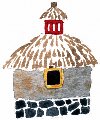
 |
Humidity buffering by clay walls |
This is the article from the proceedings of the ICOM-CC conference in Lyons 1999. The official version has a wrong illustration which severely damages the message. The correct version is here
Hygroscopic walls and ceilings give substantial stability to the indoor relative humidity in rooms which are ventialted at less than about one air change per hour. A few centimetres of material are sufficient to buffer the daily RH cycle, about 40cm of wall will buffer the annual cycle of RH in a room with about 0.1 air changes per hour.
The factors that define the performance of buffers that have to respond to a significant leak rate are the water capacity and the water vapour permeability. The best common buffer materials are wood, cut across the grain, and unfired clay brick. A specially designed lightweight clay made from bentonite mixed with perlite gives an excellent performance. The user of porous materials in walls and ceilings is an unappreciated aid to maintaining constancy of relative humidity indoors and deserves the attention of architects and engineeers.

This work is licensed under a Creative Commons Attribution-Noncommercial-No Derivative Works 3.0 License.